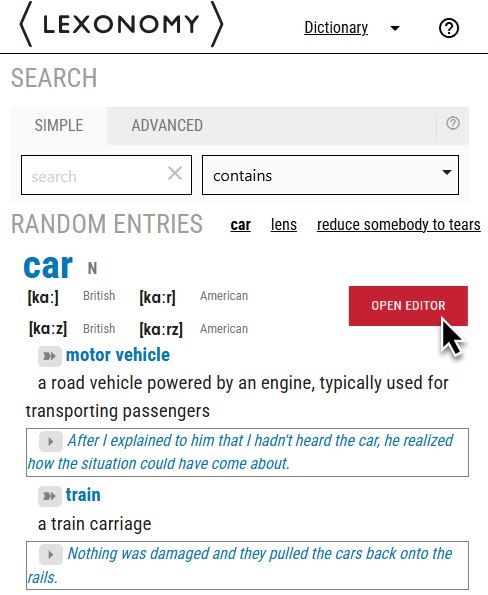What is Lexonomy?
Lexonomy is an online dictionary writing system designed for writing dictionaries, glossaries, terminology lists and others similar publications and databases.
It is a language independent dictionary editing tool which allows the author to develop all kinds of dictionaries and glossaries:
- monolingual
- bilingual
- multilingual
Lexonomy is completely flexible and, therefore, suitable for massive dictionary projects as well as small and simple works such as glossaries and lists of terminology. Lexonomy is also a key component of the Dictionary Express editing method.
Lexonomy is developed by Lexical Computing, the company behind the Sketch Engine corpus system and the Dictionary Express editing method.
Publishing your dictionary
Dictionaries can be published directly in Lexonomy. Users can gain access to the dictionary via a dedicated link and search the entries in a presentation interface provided by Lexonomy. The interface supports all internet-enabled devices.
Print, online or software integration
Your dictionary data can be downloaded in the nvh or xml formats and published online on a stand-alone website or as a printed dictionary. The data can also be integrated with other software products such as apps or language learning apps.
Separation of content and presentation
Lexonomy observes the principle of the separation of content and presentation. This means that the dictionary data do not contain information about how they should be displayed or presented to the user. They do not contain information about fonts, colours, sizes, or layout. The visual and designed aspect is controlled by the environment in which the data are presented.
This makes the data easily adjustable to the requirements of their presentations. They may be displayed or presented differently in a print book, completely differently on a website or in a mobile app.
Lexonomy contains a presentation module where the styling and design parameters can be set for publishing the dictionary in Lexonomy.
Structured and future-proof data
Such structured data can be easily converted into other formats or used in different applications, including those which will only be developed in future.
Presentation – fonts, colours etc.
The presentation and the design is controlled by the environment in which the data will be presented – by the website design, the app or the software in which the data will be used.
Lexonomy contains a presentation module. If the dictionary is to be published in Lexonomy, the colours, fonts, bullets etc. can be set in this module. These settings will not affect the raw dictionary data.
Entry structure
The structure of dictionary entries in Lexonomy is not limited in any way. Entries can contain any common elements as well as specific elements required by specialized dictionaries. Multimedia are also supported.
Here is a non-exhaustive list of the possible entry elements:
- headword
- part(s) of speech
- frequency of use
- pronunciation(s)
- phonetic transcription(s)
- transliteration (e.g. a Chinese word transliterated into the latin script)
- word forms / derived forms
- word senses
- definition / explanation
- translation into one or more languages
- example(s) of use
- translation of the example of use
- collocations
- collocation examples
- synonyms / antonyms / thesaurus (with examples)
- related words
Multimedia elements
- links to webpages
- images (illustrations of the meaning, photos, scanned documents etc.)
- sounds (pronunciation, example sentence recordings or other sound files
- video
- animations
- interactive online content
None of the elements are compulsory. The user decides which elements are necessary for the concrete dictionary. Users can also introduce their own elements not listed above.




